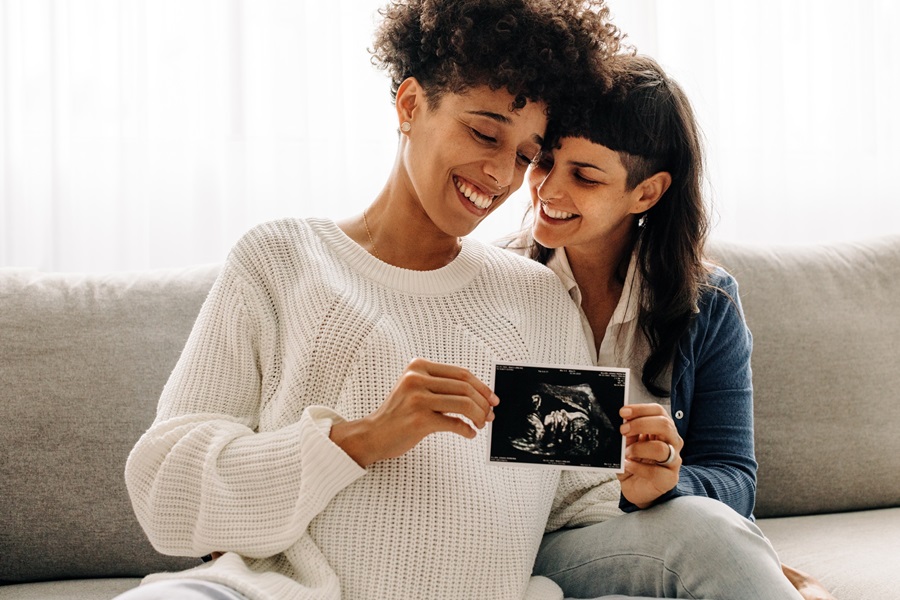- Home
- Mind & body
- What to expect in each of the pregnancy trimesters
At CBHS we help you manage your health challenges. We believe in offering you the services, support and tools you need to live your best life.
Our Better Living Programs are available to support eligible members towards a healthier lifestyle. Each Better Living Program is subject to its own eligibility criteria.
Contact us for more information and to confirm your eligibility for a program.
What to expect in each of the pregnancy trimesters

A typical pregnancy lasts 40 weeks, but it can be anywhere from 37 to 42 in length. There are three main pregnancy stages, which are known as trimesters − each lasting for between 12 and 14 weeks. In each trimester, your body will change in different ways and your baby will grow and develop. Knowing what changes are likely to happen to your body can help you plan and prepare.
Pregnancy date counting starts on the first day of your last period and conception takes place in week two.
First trimester – weeks one to 12
The first trimester is a very important time in your baby’s development as it’s when all the major internal and external body structures form. It’s important to avoid smoking and alcohol during this time (and during all pregnancy stages) and to make sure that any medications you’re taking are safe to take. If you have any doubts, it’s best to ask your doctor as these habits can cause serious pregnancy complications and birth defects.
How your body changes
This is when most women start noticing some early signs of pregnancy. Often, the first tell-tale sign is a missed period, but some women will also experience other early pregnancy symptoms. There are also women who may not experience symptoms at all.
In this trimester, you might also notice some of the following changes to your body:
- breast changes such as darkening of nipples and tenderness
- urinating more frequently
- tiredness or exhaustion
- dizzy and light-headedness
- cravings or revulsions for certain foods
- nausea and vomiting, also known as ‘morning sickness’
- heartburn
- constipation
Some women find they need to rest more than usual during the first trimester. By the end of the first trimester, some women develop a small bump in their lower tummy.
Read more about the early signs of pregnancy in our blog article.
Many women wait until the end of the first trimester before making a pregnancy announcement. However, as an individual, that’s completely up to you!
How your baby develops in the first trimester
Your baby’s development changes week by week during pregnancy. During week three, the fertilised egg moves along the fallopian tube towards the womb (uterus). They start out as a single cell and divides and multiples into over 100 cells by the time they reach the womb. By week four, your baby is an embryo and firmly attaches to the inside wall of your womb and starts to grow and develop. At the end of week five, they are around 2.5mm long and their brain, heart and spinal column will start to form.
By week six, your baby is starting to look a bit like a tadpole. They’re around 5mm long by now and their heart will be beating quickly. By the end of week seven, arms and legs, and internal organs are starting to take shape, and by the end of week eight, the face is starting to form. Week nine will see the embryo at around 1.7cm long and the facial features are becoming clearer. The skeleton is also starting to form.
By the end of week 10, all your baby’s organ will be formed, but not functioning yet and the skeleton will be continuing to develop. By week 11, the baby is around 4.5cm long and weighs around 10 grams. Their fingers are also starting to grow nails and the brain and nervous system are almost completely developed.
You can read more about the changes happening in the first trimester at the Raising Children Network.
If you haven’t already, the first trimester is when you need to start arranging antenatal care for yourself and your baby. You can start by seeing a GP who can provide you the referrals that you need. You’ll also need to choose whether you are going to use the public or private system. You can read more about having a baby in the private system here.

Second trimester - weeks 13 to 27
This is the middle of the pregnancy stages, and many women find that they are starting to get some relief from those early symptoms like nausea! Most of the hard work of forming your baby has now been done, and you may start to feel a bit better and have more energy. During this trimester your baby will increase its size by three to four times, meaning your bump is about to grow!
How your body changes
While the nausea and tiredness has started to lift, you may start to experience cravings and also some weight gain as your body fluids increase and your placenta grows. This extra blood volume can lead to you feeling warmer than usual too, which can be quite uncomfortable in the summer months. Some women notice their hair and fingernails become either stronger and thicker, or weaker.
Now that your centre of gravity is changing, it’s also time to be extra careful, or avoid, climbing ladders or doing activities which require balance or heavy lifting. Put those high heels back in wardrobe for later! If you’re unsure about what exercises or activities are safe in pregnancy, your midwife, GP or care team will be able to answer any questions you have.
You may also experience some Braxton Hicks contractions from 26 weeks. These painless contractions prepare your uterus for labour.
How your baby develops in the second trimester
By the end of week 13, your baby is about 7.5cm and weighs 30 grams. Bones are hardening, and hair is starting to grow on your baby’s head and eyebrows. By week 15, your baby should measure around 9.5cm and weigh about 80 grams. They may start to suck their thumb. By week 16, your baby’s eyes are still sealed but they’re able to make facial expressions. By week 17, external sex organs have formed and your baby’s kidneys have started working. Your baby may be able to hear loud noises. At week 23, your baby measures around 20cm and weighs 540 grams and can start to recognise light and pain. By week 27, your baby weighs about 920 grams and can open their eyes.
This is also the trimester where you may start to feel your baby move. How exciting! And, others may be able to feel those baby kicks too!
To find out more about the second trimester of pregnancy week by week at the Raising Children Network.
Third trimester – weeks 28 to 40
Congratulations, you’ve reached the third trimester and the countdown is on to when you’ll be holding your baby in your arms! This is the trimester when your baby’s organs and systems will mature, ready for birth. Your baby is by now getting big and, with less room to move in the tummy, you are likely to feel much more movement as they explore. In the third trimester, you’re also likely to be finding yourself feeling uncomfortable, tired and even emotional.
How your body changes
The most obvious physical change during the third trimester is your tummy, which will likely look visibly pregnant. You may also experience some swelling and aches and pains as well as backache, heartburn or indigestion. As your baby grows, it’s also putting pressure on your other organs, so you might notice yourself getting breathless or needing to empty your bladder a lot more often. Yes, this pregnancy stage can feel like it goes forever!
Some women even experience carpal tunnel syndrome during the third trimester. The carpal tunnel is a small passage in the wrist where nerves and tendons pass from your arm into your hand and fingers. During pregnancy, hormones cause you to retain fluid and they also soften the ligament that forms the roof of the tunnel. When this happens, the nerve running through the tunnel may become squashed. Symptoms are likely to resolve after the birth of your baby.
This trimester, some women might start their maternity leave to ensure they can be comfortable and get enough rest.
How your baby develops
During the third trimester, your baby will gain a lot of weight, start practicing breathing and their hair will continue to grow. By week 33, your baby should weigh around 1.9kg and measure about 29cm in length and by week 37, they weigh about 3kg and measures 35cm. Your baby will be considered “full term” once it reaches 38 weeks, and you might want to have your hospital bag packed and ready! If you’re still pregnant at week 40, don’t worry. Very few babies arrive on their due dates and around half of all pregnancies go past 40 weeks. For most women, labour starts naturally between weeks 37 to 42.
To find out more about how your baby develops week to week, visit the Raising Children Network.
Where to get more information
Talk to someone
- Pregnancy, Birth and Baby helpline on 1800 882 436. You can speak with a maternal child health nurse by phone or video call between 7am to midnight, seven days a week
- Parent helplines in your State or Territory
- Miracle Babies Foundation support line on 1300 622 243. This service can help families with a threatened pregnancy or help families with a baby in Neonatal Intensive Care Unit (NICU)
Online resources
- CBHS pregnancy and birth guide
- How your baby develops week to week at the Raising Children Network
- Birth Choices at the Raising Children Network
- Feelings, relationships and pregnancy at Pregnancy, Birth and Baby
- Tests, scans and checks in pregnancy and labour at Better Health Network
- Dad’s guide to pregnancy at the Raising Children Network
Sources
https://www.pregnancybirthbaby.org.au/early-signs-of-pregnancy
https://www.pregnancybirthbaby.org.au/first-trimester
https://www.betterhealth.vic.gov.au/health/healthyliving/pregnancy-stages-and-changes
https://raisingchildren.net.au/pregnancy/week-by-week
https://www.miraclebabies.org.au/
https://www.pregnancybirthbaby.org.au/braxton-hicks-contractions
https://birthchoices.raisingchildren.net.au/index.html
All information contained in this article is intended for general information purposes only. The information provided should not be relied upon as medical advice and does not supersede or replace a consultation with a suitably qualified healthcare professional.
Health and wellbeing
programs & support
You Belong to More with CBHS Hospital cover:
- Greater choice over your health options including who treats you
- Get care at home with Hospital Substitute Treatment program
- Free health and wellbeing programs to support your health challenges
Live your healthiest, happiest life with CBHS Extras cover:
- Benefits for proactive health checks e.g. bone density tests, eye screenings
- Keep up your care with telehealth and digital options
- Save on dental and optical with CBHS Choice Network providers
